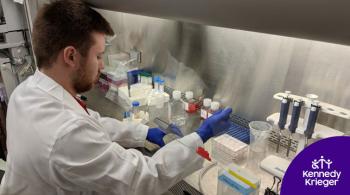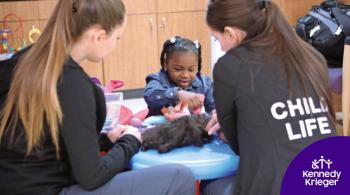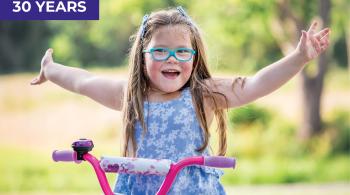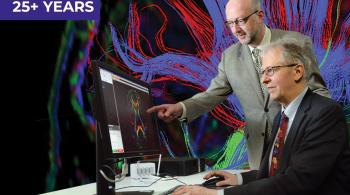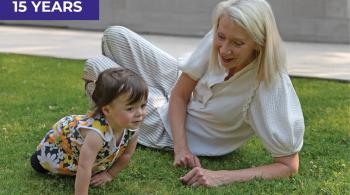Building Brains Through Connection: How Social Interaction Shapes Emotional Intelligence in Children
For children, social interaction isn’t just play—it’s brain-building. When children connect, share, and empathize, they are also strengthening the neural pathways that shape emotional intelligence, communication, cooperation, and lifelong learning. Join Brad Schlaggar, president and CEO of Kennedy Krieger Institute and his guests Drs. Maya Opendak and Tomomi Karigo as they discuss the development of our brains’ neural systems for social and emotional behavior, and the factors that can interrupt that development.
Learn More About Kennedy Krieger Faculty & Staff Members Featured in This Episode
Learn More About Kennedy Krieger Faculty & Staff Members Featured in This Episode
View Episode Transcription
Dr. Brad Schlaggar (BS): Welcome to Your Child's brain, a podcast series produced by Kennedy Krieger Institute with Assistance from WYPR. I'm Dr. Brad Schlaggar, pediatric neurologist, and President and CEO of Kennedy Krieger Institute. Humans are fundamentally social beings. By social, I'm not only referring to social interactions, but more broadly, referring to the reliance we have on communication, cooperation, and connectedness for our survival. One indication of the salience of social behaviors for humans is that among the very first behaviors we see in typical human development is the emergence of a socially responsive smile in the first months of a newborn's life. Now, the way we interact socially changes as we grow and mature, as do our expectations of how others will interact with us socially, those changes in behaviors and our expectations for age appropriate behaviors reflect changes in our brains. More specifically, they reflect changes in the neural systems in our brains that are responsible for social interactions. The development of social behavior progresses from basic responses like regarding a face visually, social smiling, as I mentioned, and eye contact in the first few months to more complex interactions in infancy, such as imitation of behaviors and sounds, following a caregiver's gaze, demonstrations of joint attention. As a toddler, the emergence of behaviors like complex social play and interactions with peers. Now, atypical social behavior is a very common feature of neurodevelopmental disorders such as autism spectrum disorder, as well as many disorders of mental health, like anxiety, schizophrenia, and effective disorders. The causes of these conditions and their neurobiological bases are complex, multifactorial, including both genetic and experiential risk factors. Among those risk factors is early adversity, which can contribute to the scaffolding of maladaptive and potentially lifelong social deficits. Indeed, research shows that for humans, while some children are born with an intrinsic or genetic risk for atypical social development. For others, the quality of early relationships can have a powerful impact on how a child's brain develops. Children who experience profound social and emotional deprivation, for example, are at great risk of facing challenges with social and emotional development and growth. Children who are born already at risk for atypical social development, when exposed to such adversity, seem to be at even greater risk of having negative consequences of that adversity. Those consequences, well, they can extend beyond social interactions and include negative effects on cognition, on learning and memory, and communication, as well as disorders of mental health. Exactly how the brains, systems, and circuits for social behavior develop is incompletely understood, but of critical importance, given the potential lifelong ramifications of disrupted social development. In today's episode of Your Child's Brain, we'll delve into what we know and what we need to know about the development of the neural basis of social behaviors. Today, to dive into this very interesting topic, I'm joined by two of my exceptional colleagues from Kennedy Krieger Institute. They're Dr. Maya Opendak, a neural scientist who leads the Social Development Basic Research Lab at Kennedy Krieger Institute. She's an assistant professor in the Department of Neural Science at the Johns Hopkins University School of Medicine. Dr. Tomomi Karigo, who's also a neuroscientist studying the development of social behavior at Kennedy Krieger Institute, is also an assistant professor in the Department of Neuroscience at the Johns Hopkins University School of Medicine. Welcome Maya and Tomomi. Maya let's start with you. I mentioned some aspects of social development in that intro. Can you speak more? What do we mean by social development and early childhood?
Dr. Maya Opendak (MO): Thank you, Brad, for having me on this podcast, and I'm excited to talk about this topic, which is, of course, of great interest to me. I think with social development, we like to think of how the environmental demands are changing and what is required of the individual and interacting with other individuals. The social behavior of a baby, for example, is not the same as a social behavior of a child versus a teenager versus an adult. When you're younger, all that's required is that especially for individuals from species that are born mature, what's required is that you approach a caregiver who can provide necessary life sustaining resources. You don't really need to make decisions about your social behavior. The brain's ability to support this approach bias towards a caregiver who can provide resources. The brain social behavior network or the regions of the brain that interact to support this infant type of social behavior like social smiling or other behaviors that support this for formation of attachment to a caregiver. Those social behavior circuits change as individuals mature and other things are required of them. Once a child has to go to school, for example, interact with other kids, other brain regions become more involved in social behavior, those might be important for assessing threat in the environment. That's especially important as individuals mature and enter complex social hierarchies where other individuals might actually be a source of danger to them. Then this, of course, goes into as you get older, finding opportunities not only for social interaction, but for mating and reproduction. As these different social demands of the environment change, the brain changes to support that flexible behavior.
BS: I just laid out some additional types of social development. What other types are that we can add to the discussion to flesh out what we mean by this space.
MO: The social development, when we think about it, it's a word development, but the phases that include the development that's quite diverse. For example, like it's from the baby being the infant to becoming a kid and then becoming a young adult. So I want to emphasize that the social development, when we think about it, we really need to think about what necessary behavior they need to develop each phase they’re in.
BS: I also talked about some of the relationship between brain structural and functional development and social development. Let's talk a little bit more about that interplay. Between brain development and social development.
MO: I think the brain is one of the very interesting organ in the body. Then when we think about the development, brain is one of the organ that complete the development the latest in our body. When we think about the neurons, the neurons in the brain start to be born in just a several weeks after the conception, but the brain continues to develop and fine tune until the animals reach to the maturation, which is like in humans, it's almost like 20-years-old. When we think about this brain development and social development, is very much intertwined and then it's affecting each other so that social experience shape our brain and brain circuit. Also the brain development itself is shapes how we respond to our environment in a social environment. It's a ultimate feedback keep going until it animals reach to the adulthood. It's not completely there. It's also our behavior and then brains keep changing.
BS: Let's talk a bit more about what kinds of brain mechanisms support the development of social behavior in children.
MO: In very early life, a lot of what we know about brain mechanisms important for social behavior are from animal models, including rodents and non human primates. But a lot of the brain regions involved are also present in human children. We've observed that in the field, that in very early life, The drive towards approaching a caregiver involves a very simple circuitry related to learning about those caregiver cues. In rodents, for example, it involves circuitry, important for learning about orders. Once that order is learned, infants will approach the caregiver based on that order. As infants mature, other brain regions become more involved that can control the approach towards a caregiver and suppress that approach in preparation for independence. These changes involve a brain region called the amygdala, which has been shown to be important for learning about fear in the environment.
BS: Tomomi, can you build on that? How do these kinds of mechanisms change over the course of development as the environment changes?
Dr. Tomomi Karigo (TK): The development is not static process, as dynamically changes as the animal goes through the different environment, and also themselves growing up during this process. Depending on what kind of environment the infant or child, their socket adaptation will be modified, and also how these environmental process will be changing depending on what's the stage of the development they're in. For example, as Maya said that in the infants, the caregivers information is very important for the babies. But for example, kids in the adolescents, those caregivers information is not as critical for them to survive in the environment. The signals that child responding to may be different depending on their age, and then that's good shape how they respond to the social cues.
BS: Both of you, your expertise is in dissecting these behaviors in the laboratory. I'm hoping that both of you could tell us about what your approaches are, how you do it. How do you go about studying the circuits that underlie social behavior? Maya I maybe begin with your approach, the kinds of paradigms that you use to dissect those complex behaviors.
MO: Sure. The important thing is using age appropriate techniques here. A lot of our work is adapting. Most of the tools that we use in this field were designed for use in adults. Those are really helpful and important. But in order to understand how the social brain is developing. We need to actually take into account the unique capabilities of the species that we're using and the age of the species that we're using. For example, you can do a social approach test, behavior tasks that assess how likely are they to approach another animal versus some interesting object in the environment. But that's important test. But for a newborn, they can't their eyes aren't open in our species of interest, and they can't move very far. Another pup that they've never met before, which is what you would usually use, like a novel stimulus, a stranger. That's not really motivating to them. We're guiding our experimental design by the ethology of the animal. The unique environment that this animal typically inhabits. When you study social behavior mechanisms in the newborn, what we do is we put them with their mother or another female in a very small cage and we see how they approach the caregiver, for example, like how long it takes. Then we can use assays that look at what brain regions were active during that behavior. We have techniques where we can say, well, this brain region, such as the one I mentioned, the amygdala, we can specifically turn that brain region on or off using viral mediated gene transfer. There's a couple of different ways to do it, but you can specifically target neurons that you care about, circuits that you care about, regions that you care about, and then look at the behavior of the animal while they're doing the different age appropriate tasks and ask whether or not the activity of that brain region is important for that behavior.
BS: Tomomi.
TK: Sure. My lab is very much interested in understanding how social behavior develops, especially during the adolescence period. Then to understand what is happening in the brain during the social interaction is happening, and then also how could the social information be processed? In some cases, when the IMS go through some treatment, and then they show the different social responses, understanding how the social information is processed would be very important. From the past studies from other groups many years of studies, or also our own studies, we identify particular brain lesions that are potentially involved in the social interactions. What we often the approach we would take is look at the neural activity of these brain lesions, while animals are interacting each other, and then how these brain lesions or particular pipe of neurons in the brain. What information these neurons are care about, how they're responding to the stimuli, and how it's coordinate to the behavior. That is the approach we are trying to understand the mechanisms and then neuro coordinates that is involved in the social interactions.
BS: Tomomi, I'm going to stick with you and just ask, I'm really interested for both of you, but start with you, Tomomi, how did this particular interest in social development in adolescents? Where did that come from for you as a scientist?
TK: Well, when I was kid, I've been very much interested in understanding what's going on in the animals mind. I had a puppy when I was a kid and seeing him to grow up and interact with us and also other animals and other dogs as well. When you look at the, for example, kids or other animals growing up, you do see huge changes in behavior interactions from the childhood to they become fully adult. Even though as a child, they can function on their own and they can decide what they want to do. Somewhat they look like a little adult, but that their behavior is still not mature. But as they become older, then they start to show different set of behavior. That's made me very, very interested in what is happening in the brain and how the child or young adult process the information leading to our behavior output. I won't understand what's the black bust box.
BS: Really long standing interest in behavior, especially social behavior, how it develops at your roots. Maya how about you? Where did this interest, particularly in early infancy? Where did that come from?
MO: I went into my PhD really interested in the biological basis of memory and not just memory, but the entire human experience. A lot of neuroscience is identifying that there are physical bases for our feelings and our thoughts and our memories, and so I wanted to understand memory, really. I joined a lab, Dr. Elizabeth Gould, who was looking at social memory in rats, and I studied adult rats and dominance hierarchy formation, so how rats live in a community and how they all learn their respective roles. I saw that even a brief period of stress in adulthood could reorganize the hierarchy and their behavior and their memory through changes in their brain structure. Then I also was curious about developmental psychology, this is true, I saw this documentary, and this is not an advertisement for that, but it's an amazing documentary called Seven Up, and it tracked children in England from the age of seven to adulthood, and this one child, there was such a massive change in him between the age of seven and 21. He was just this really brilliant, cheerful little kid, and then by the time he was 21, he didn't have a home, and he was battling serious mental illness. I became interested in applying that same idea. Even a brief experience of stress in adulthood can change social behavior. The way you interact with the social world can even create more stress for you, so if you're coming into it with impairments, that can cascade and prevent you from improving because you can't get the social support you need. All these different things coalesce and made you want to understand, what is it that can happen in childhood that can predispose you to a lifetime of challenges, I guess, and are there ways to intervene?
BS: That great segue into this concept of adversity and how it's impacting development that we've been touching on, your comments have touched on, but when you think about adversity and those impacts, do you see it as likely that the impacts are specific for certain brain circuits, for example, those that have to do with social development or are the effects more widespread, inclusive of brain systems for social development and beyond, how precise is the impact? Then from a brain circuitry standpoint, how do you link those early adversities to the ultimate outcome for many who have those experiences to have disorders of cognition, social interaction, and potentially mental health as well?
MO: The literature on early life stress has shown that in early life, childhood and infancy, there's heightened vulnerability so there's heightened plasticity for experience to change the brain as it continues to develop, but that also means heightened vulnerability to unexpected and species atypical, to not what you expect for your species environment or niche, I guess, there's heightened vulnerability for those impact for the environment to change your brain in a way that's maladaptive. These changes are occurring on multiple levels, multiple circuits, but to get at your question of specificity, there's a lot of work, especially from Bruce McEwen's lab and people he's trained and his collaborator showing that stress changes the brain on a massive scale, particularly in the hippocampus. But social stress, so caregiving adversity, so either a neglectful or an abusive caregiver or just caregiving that's not in line with what is typical for the species, produces changes in numerous brain areas, but specifically through the experiments that we discussed, that toggle the activity of different brain regions during behavior. In order to show a change in social behavior with these adversities, those changes occur in pups through the amygdala. There is specificity that social adversity specifically produces changes in social behavior through these changes in the amygdala. Now, another thing you brought up is about, what about moving forward? The brain of a child is different than the brain of an adult both structurally and functionally, so how can early adversity change adult behavior if those brain regions aren't even functioning the same way, if the circuits are different? This is a theoretical question at this point that we need to test and design really elegant experiments for. There's a lot of data looking at early life adversity and I also want to say there are many ways to study early adversity and many labs are doing this and you can modulate the different features of adversity to identify what's necessary and sufficient to produce a social behavior deficit. But the early adversity models, if you look in adulthood, so correlational work, shows that there's remodeling of reward pathways and increase the likelihood of addiction behavior. How does that happen if those systems aren't even present in pups or they're not functioning the same way? One idea is that a functional social behavior system for a baby, let's say it gets you to approach your caregiver who continues to provide sensory input to you. That sensory input like food or like sun for a plant, promotes the normal development of these other brain regions that are important for, say reward. Without that, they don't scaffold properly, I guess. That is one idea of how something that happens in early life can have lasting consequences. Then the other idea or related idea is, again, this behavior thing where if you alter the behavior through this early life trauma, if you're less likely to approach a social partner that can provide you with what you need, you're not going to get what you need and you're going to continue to have social inhibition issues, for example, and then again, there will be this feed forward process that continues to impact your ability to repair that initial insult. I think that's what Tomomi was getting at before as well.
BS: Yeah, Tomomi, let's pick up on that. This cascade that happens changes how the brain of an adolescent would interact with adversity, so can you contrast what it would mean for an animal who's developing without adversity, gets exposed to some stress or significant stressor in adolescence versus one who has? What's the difference at the brain level for those different experiences in response to the same stressor?
MO: Yeah, that's a very interesting and important point. In the field, there is a model called two-hit model. For example, when the animals or children who experience adversity in early childhood, and then experience maybe different adversity, but they're getting into the difficult situation again, then this child may have higher percentage to develop the phenotype that could be considered as maladaptive. Even though animals experience the adversity in early life, it doesn't mean everybody develop something like the critical behavior phenotype. Some animals may have the resilience and superficially, that doesn't manifest as the behavior outcome. But it is possible that even though it doesn't comes out as the behavior changes, maybe there are some system at the system level, there are slight changes in that brain circuit and that changes could be manifested to after experience another round of this stressful environment. It's very important to think about what is the history of that animal or the child, what they have experienced before is really changes how we interpret the data we are getting from them.
BS: Yeah, this two-hit model is an important construct. You made another point about not everybody who is exposed to adversity necessarily has these long term consequences, Maya, can you speak to that? What do we know about potentially protective effects that might mitigate the likelihood that stressors change these brain circuits?
MO: There's this idea of resilience versus vulnerability in response to stress. In early life you note it is difficult to pinpoint the mechanisms of resilience because in naturalistic models of stress, for example, in a human sample, you can collect tons of demographic data, can you can have surveys about what different experiences have you had and you can systematize all this information in your assessment and try to identify what factors are more likely to produce immediate and long term outcomes. The quality of this, again, we're trying to accomplish two things. When we use animal research, we want it to give us meaningful insight into what could be happening with children so that we can identify risk factors and things that promote resilience to early life stress and not have it be too contrived but at the same time, we want to understand mechanisms and be as specific as possible because that's one of the benefits of using animals to begin with. In order to understand mechanisms of resilience and vulnerability, one way to approach this is to make sure that all the animals, for example, are receiving the exact same treatment in early life because timing, duration, intensity of the type of stress you experience as a human or as a animal non human animal, can influence the likelihood the impact it will have on you. Abuse, neglect, these are all important differences. There's lots of models I said of early life stress that ask what are these important features. But we do know, for example, in humans as well, that experience that's not related to caregiving, for example, produces different outcomes so just repeated stress of living in a country that's constantly in a geopolitical conflict, you don't have resources. One of the important things though that does seem to confer resilience to that type of stress is responsive and attuned caregiving. That's unrelated to caregiver maltreatment or maltreatment by a caregiver. If you're in a situation that's stressful, the presence of a caregiver can buffer that. That relationship between the child and the caregiver can impact the quality of attachment, and high quality attachment is shown to promote resilience to these types of chronic stress. I'm making a separation between adversity in a caregiving context and adversity, not in a caregiving context. But one thing we've seen is that the way for caregivers to be able to be responsive and attuned to their children is directly related to how stressed they themselves are. What's come out of all of this is that the best way to help children is to help their caregivers to make sure that they have the resources that they need in order to effectively buffer all the different stressors that in the environment that they themselves can't control.
BS: This is a really important clinical point because the child who's exposed to duress, it's often the case that the parent is in the same environmental risk setting for that same stress. From a intervention standpoint, we think of a dyadic approach, treating both parent and child in order to ameliorate the effects of that trauma or other forms of adversity. I think I'd like to move on to hear about how you both are thinking about what's exciting in the field, the next wave of exciting, impactful research that you see coming that makes you feel really compelled to be in this line of work. Tomomi, maybe you start out.
TK: Sure. I think we are in a very, very exciting time in the research. The study in the brain development and social development, it's not a new field. Many people have been doing great research, and we are all standing on all these great research. But there has been a limitation what we can do in the developing brain, especially when we try to understand the detailed mechanisms using the animal models. Animals models are great because we can actively do the intervention so that we can understand the underlying mechanisms in a precise manner that will help us to develop some future treatment. But when we think about the developing brain, this has been challenging because first of all, the brain is much much smaller than adult brain. Also when we think about the development, the window we can deal with is very limited. For example, when we think about childhood in human, it has many years, but when we think about in rodent model, the developmental period, for example, adolescence period, will be just one or two weeks we can do some intervention. This has been a challenge for us to be able to precisely target the neural circuit to understand what's going on in the brain but that challenge has been changing, so we are now starting to be able to manipulate the neural circuit in tiny brains and also with the new microscopic technology development, that's starting to enable us to be able to track the brain what is happening from the infant to become a child to adolescence and becoming adult, so that as the animals experience the adversity and as the animals develop their deficiencies or changes in their social behavior, we can now start to look into the brain, what is happening, how the brain is responding to this situation so that we'll be able to have the complete picture of what's going on in the brain.
BS: Maya, how about you? What excites you for the future of the field?
MO: Complimentary to what Tomomi was saying, right now, there's this proliferation of tools that let us look very, very broadly at brain changes and hormonal changes and gene expression changes with high powered computing, we can identify novel targets for intervention and novel biomarkers, so for example, we can model a bunch of different adversities, a bunch of different ages, take the data from the brain and just do a huge screen and identify new brain regions to look at that seem altered by this experience or functionally different across development or new genes to look at or metabolites to look at. This is very exciting because we can combine that with these hypothesis driven techniques that we can use to target very specific circuits based on literature. But then we can also identify new paths forward and it's just very exciting because there's just so much work to do in this space. These interventions can then be applied eventually in human populations as well.
BS: Well, I think that's a great place to end. I want to thank our guests, Dr. Maya Opendak and Tomomi Karigo. We hope that you as listeners have found this discussion interesting and informative. Please check out our entire library of topics on your child brain at wipr.org kennedykrieger.org/ycb or wherever you get your podcasts. You've been listening to Your Child's Brain. Your Child's Brain is produced by Kennedy Krieger Institute with assistance from WIPR and producer Mark Gunnery. Please join us next time as we examine the mysteries of your child's brain.




